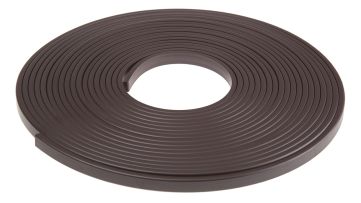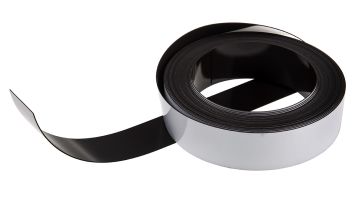A Complete Guide to Magnetic Tape
An easy to follow guide that explains all you need to
know about magnetic tape including the various uses.

What is Magnetic Tape?
Magnetic tape is an ingenious and versatile alternative to adhesive tape, ideal for use in commercial environments. As the name suggests, the product makes use of magnetism rather than conventional adhesive for its primary gripping power, allowing quick and easy adjustment, removal and reuse.
Some of the most common constituent materials of magnetic tape are strontium ferrite or barium ferrite.An alloy of these elements with magnetic iron particles is typically encased in a heat-sensitive plastic binding material to create the finished product.
What is Magnetic Tape Used for?
Commercial magnetic tape is used in a wide variety of settings and applications for many different purposes. Just a few potential environments where magnetic tape could be used include shops, factories, exhibition halls and similar environments where signs, posters, dividers, placards and point-of-sale material are displayed but also routinely changed.
Other uses of magnetic tape include:
-
Creating a temporary storage space for ferromagnetic items (i.e. made from a material that is attracted to magnets)
-
Storing tools or other items close to machinery for speed, efficiency and ease of access
-
Holding handleless doors closed
Magnetic Tape Data Storage
Additionally, a different type of magnetic tape was used as a method of storing media such as video, audio, and computer code until the development of modern information technology. Although magnetic tape is being used less and less nowadays, it is still sometimes used as a medium for archiving, backups, and data storage. This is because it is a capacious medium and therefore provides more storage space than alternatives like USB sticks and rewritable disk drives. However, with the rise in popularity of cloud-based services, tasks like routine computer backups are becoming increasingly less likely to use a magnetic tape storage solution.
Magnetic tape also has drawbacks as a data retrieval medium. It is a ‘serial’ access product, meaning that the reading device must fast-forward through the tape from the beginning to access a particular piece of data. This is a slow and laborious process in comparison to RAM (random access memory) which can be accessed in any order.
Types of Magnetic Tape
Magnetic tape is available in a variety of lengths and materials, with a range of backings for different circumstances. It is usually easy to cut if you require a specific or more precise length.
Here is a little more detail on some of the different types of magnetic tape:
Adhesive Back Magnetic Tape

As the name suggests, this form of magnetic tape features an adhesive layer along the back, allowing it to be attached to straight or curved surfaces which are not ferromagnetic.
The pressure-sensitive adhesive included on many such products allows for easy application. Self-adhesive magnetic tape can also be doubled (one strip can be laid on top of another) for an additional magnetic charge.
Plain Back Magnetic Tape

Plain magnetic tape is a variation of adhesive back tape, with no adhesive included. This allows users to apply their own - making this product ideal for use in specialist settings.
ช่วงดูTraditional Back Magnetic Tape

Traditional back magnetic tape is simply tape with a magnetic rather than adhesive back. It is ideal for use in environments with abundant ferromagnetic surfaces - for example, the steel racking in warehouses.
Traditional back magnetic tape frequently features wipe-on, wipe-off surfaces for the creation of temporary signage to display key information such as stock levels and product codes.
FAQs
How Much Data Can a Magnetic Tape Hold?
On average, around one terabyte of data can be stored on a single magnetic tape. To put that into context, modern desktop PC hard drives typically have a capacity of anything from 1 up to 16 terabytes.
How is Data Stored on Magnetic Tape?
Magnetic tape is coated with magnetic particles. The recording device converts the data to be stored into magnetic pulses which move the particles into patterns. These patterns are reconverted to access the data at a later date.
There are two basic recording methods - linear writing and scanning. The former arranges data in long tracks along the length of the tape, while scanning creates dense tracks across the width. Scanning was devised to allow denser data storage. There are several variations, of which the most widespread is helical scanning - writing data diagonally across the width of the tape.
Why is Recording Tape Magnetic?
Recording tape is magnetic because the manipulation of magnetic particles is an efficient and cost-effective way of storing data for later retrieval - and music is a form of data at this basic level. Nowadays, though, modern computer drives have largely replaced magnetic tape as the primary medium for recording.
How Strong is Magnetic Tape?
The strength of magnetic tape can be calculated using the following formula
-
Calculate the surface area of the tape by multiplying the length by the breadth, for example, a piece of 30cm long magnetic tape which is 2cm wide will have a surface area of 60cm
-
Multiply this figure by its adhesive force per square centimetre, for example, 60cm² x 100g/ cm² = a maximum strength or pull force of 6,000g (6kg)
Is Magnetic Tape Attracted to Itself?
Magnetic tape is available in two forms - type A and type B. Opposites will attract, for instance, if two pieces of the same type are placed on one another, each will repel the other.
Related Guides
Wood Screws Guide
Our handy guide is here to help you easily identify which size and type of wood screws you need for your project.
Neodymium Magnets
Learn everything you need to know about neodymium magnets and see some of the best products available in our guide.
Tap Washers Guide
Which tap washer is best? Our guide explains everything you need to know about the types and sizes available.